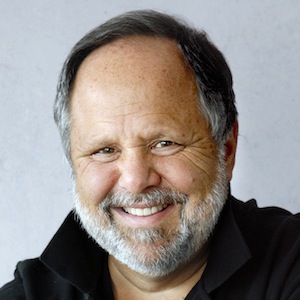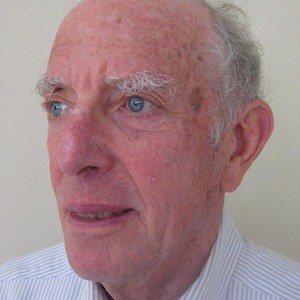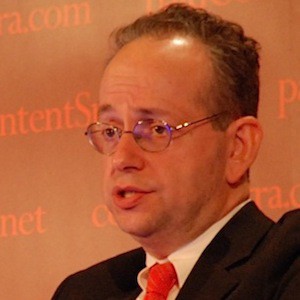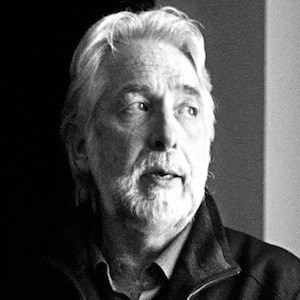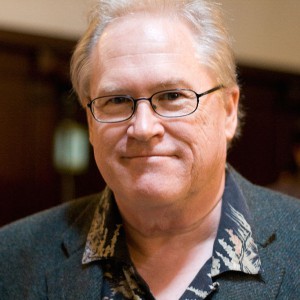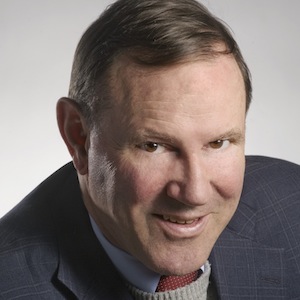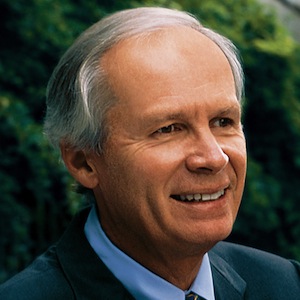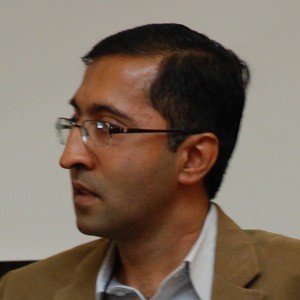Martin Nisenholtz I should say that we’re with Larry Kramer on March 7th, 2013… Larry is currently publisher of “USA Today.” One of the real rock solid themes here is that there’s this thing that John Huey calls the “tide,” which are the technologies, events and companies that are formed. Then there are the “swimmers.” These are the people who are making the decisions and trying to find their way through this tide.
One of the key questions is whether the tide is just so freaking powerful that no matter what decisions the swimmers would have made along the way, they would drown.
Some people very strongly [believe] that that’s the case. Other people believe that very critical decisions were made at a certain point in time that really, really put us in this fix. I’m going to start with “MarketWatch” in a moment, but three of those things are “free versus pay.” The original sin — people like me giving away content.
Second is the idea of open links, the notion that the world of professional content and journalism would just make itself available through RSS readers, which, of course, I pioneered with Dave Winer. That’s the second original sin.
And then the third one which I frankly had nothing to do with, was that we just weren’t very aggressive with copyright. That we let folks like the “Huffington Post” abstract stuff at a level that was certainly what many people considered to be well beyond fair use.
Larry Kramer: We never defined “fair use.”
Martin: Right. We never defined fair use, so let’s start … with a very simple question. We’ll get into these three themes, but how did you arrive at Marketwatch and how did it get founded?
Larry: That’s a good question. I was in the newspaper industry until 1990 or so. I’d had for five years made just 35 to 40. My dream job. I was editor of the newspaper in San Francisco, the “San Francisco Examiner.” Right around 1990 we hit a recession — an ’89-’90 newspaper recession, real recession but hit newspapers. I got depressed, because I had spent half a year not doing journalism but doing buyouts and layoffs and all that stuff. I came to a mutual agreement with my publisher at the time, Will Hearst, that this wasn’t for me anymore.
The Hearst people were great to me. They basically bought me a year. It’s like being granted some time from the university to think. I took the year. I actually went out to see what I wanted to do. Did I want to just get another newspaper job or whatever? I decided something was happening. I was getting a little…
Martin: Did you have the Harvard MBA by then?
Larry: Yes. I had my Harvard MBA. I got it for totally different reasons. I got that right out of college. I was a Syracuse undergraduate in journalism, and I applied to the Harvard Business School saying, “I have no interest in going in business. I want to cover business,” and I thought this would be a cool way to do it because I’d get great sources and I’d learn about what I had to cover. They took me. It was the only place I applied, because I thought the case method was perfect for a journalist, and I wasn’t really ready for reading finance books and things like that. it was a great education for me.
I always had it in my background, but I used it more as a journalist. I covered business. I had great sources in the banks.
Martin: At the Post.
Larry: Yeah, at the Washington Post. But I had always envied some of my classmates, which were among the first who were becoming very entrepreneurial. They tracked our class from the business school very…John Kotter tracked our class, because it was the 25th anniversary after the class of ’49, which was a famous class that had a bunch of corporate CEOs in it. In our class by the ’90s had become…You can see more than half were entrepreneurs, had made their businesses, had built businesses as opposed to having grown in the traditional businesses. That clearly some of the entrepreneurial spirit came out of my time there and the people I knew since who were doing that.
But I was really kind of flailing about, and I thought there was going to be a real movement toward electronic carriage of news and information. There was no Internet then, per se. Will Hearst had shown me some things when I was at the “Examiner.” He was on DARPANET and he would…
Martin: There was no browser.
Larry: But no browser. It all looked the early days of CompuServe. It was just text. I had this idea about transmitting sports information to portable devices using FM sideband. The FM sideband was being used for — this is more than you want to know, I’m sure — used by a product called QuoTrek, which was a stock market. The only portable stock market device. It gave you real time stock quotes. The data was being transmitted in an FM sideband into a device, a radio receiver that displayed data. It didn’t have music.
Martin: It was incredibly expensive, too.
Larry: It was $200 or $300 a month, $150 of which was to the exchanges for the real time data. They charge you for real time data. But it was still a couple thousand dollars a month less than having a Bloomberg terminal or a Reuters terminal or a Dow Jones Telerate terminal at the time. Individual traders were using it because it was the cheapest way to get a real time quote. You could actually get a real time quote, and the quote you got was to within seconds of real time. My partner — a very close friend of mine — worked in that business, and he was vice president of marketing for a company called Data Broadcasting Corp. That company, ironically, was part of an overall company that own among other things The Financial News Network.
He had the idea that they could do more with news. Plus he had the idea that, since markets were nine to five Monday to Friday but they owned this bandwidth 24 hours a day and seven days a week and they weren’t using it nights and weekends, he would look for some kind of information that could transmit on nights and weekends. That’s when he came to me and he said, “Could sports be that?” I said, “Perfect.”
We’d use the bandwidth. We’d transmit real-time scores and data from games, which was unavailable then. We identified the displaced fan, the person who lived in another city from the teams he loved, colleges or pros, that you could not get a score unless you dialed like a 900 number and you had to pay for it. Sports Center didn’t exist. ESPN was around, but they really hadn’t gotten into the news game yet.
It seemed like this would be cool, and I wouldn’t have the exchange fees to pay. For a lot less a month, maybe $80 or something or $70, I could sell a device that had sports scores on it. His company, Data Broadcasting, invested in me doing a startup with him. He spun out. The two of us together started a startup called Data Sport.
That was a company. Actually, they housed us. Besides investing in us, we used their equipment so they actually gave us a line of credit. We used their engineers on an ad hoc basis. We would pay for them to develop our version of their product, and they loved it. What they got out of it was they could put sports scores on their stock machines, and all the brokers wanted that. It was an interesting arrangement.
I learned a really [laughs] valuable lesson, which goes to the pay and no pay issue. Because we didn’t have a lot of money, I got “The Sporting News” to be my partner and branded it with their name on it. They agreed to market it in The Sporting News. The last thing I did was I went to Las Vegas, and I met with a guy named Michael Roxborough, who was the main odds. At the time, he was the main odds maker in Vegas.
All the hotels got their opening lines from Mike, from “Roxy,” his name was. I made a deal with him to put his ads on my machine and to start a process of getting the actual odds from the hotels because each hotel moved differently. Odds could be different on a game at different hotels. I decided just to put odds in there because I thought that would be cool, and it was a real-time thing. We did that.
We offered the product for two months free to sign up, and then you’d have to start paying. The take on it was enormous. Thousands and thousands of people wanted free ones. When it came time to pay for it, people would come back and say, “I love it, but $80 a month or 79” or whatever it was, and we dropped the price later to 49, “It’s just not there. It’s too much.”
But there was a [laughs] hardcore person who wanted that at all costs, and it turned out basically they were bookies or heavy betters. If they had money running on it, it was the same profile as the person who would get QuoTrek. If you were trading, real-time data meant something.
Martin: Like Bloomberg terminal.
Larry: Right, but Bloomberg terminal was going to professionals. The QuoTrek would go to somebody who traded heavily that was not a professional.
Martin: There was a calculation that someone could do.
Larry: Yes. He said, “If one trade works out a little better for me, I paid for the whole month, right?” They look at it. “You’re absolutely right,” and the better had the same thing because what he could do is the better could see that the line was moving before his bookie in another town. If he saw that the line was moving a certain way, he’d bet that game right away with his bookie at the old number, and he’d get a better advantage because the line would continue to move later. Depending on which way you were betting, it was an advantage to bet sooner if you could bet ahead of the bookie.
We were getting in all these guys calling us wanting to pay in cash. [laughs] It was like, “What’s going on here?” What I realized was there are a whole lot of people who wanted that information and liked it, but there was a whole separate class of people who would pay for it. That is the definition of what happened at Financial News, too.
There were a whole lot of people who would pay anything to make sure they had real-time news and financial information on those terminals. They paid $3,000 a month, $2,000 or whatever it was for Bloomberg terminal. They had to know, and they had to know right away.
Then there’s everybody else who had a lot of money in the markets who wanted that information. For them it’s free, or they’re not going to do it. There’s no money in it. They’re not exchanging. Later on, and I’ll get to that in a second, when I got to MarketWatch, that made a big difference. We did the sports business for a couple years. We got it to break even and that company, Data Broadcasting, bought it from us, because it was worth more to them.
It was an add-on to them, and it wasn’t going to make it as a separate company. That worked out fine. Gave me a little bit of money, but they said to me — this was now ’93, ’94 — “Would you stay with us and run it and also run, help us with QuoTrek, because we’re worried. We’re hearing about this thing called the Internet.”
QuoTrek’s big advantage was it had a huge barrier to entry for what they were doing. They had radio contracts with radio stations in 80 cities. They had built them over time. They had done all the stuff. For somebody to transmit real time data over an FM sideband, which was the only way available then, they couldn’t do it. It would take too long to find all those stations and do all that.
They had started delivering data over a vertical blanking interval, too, through a cable box. That started getting them thinking that, “Other competitors are going to be able to do this sooner, and there’s this Internet thing.” They said, “What could we do to differentiate ourselves?”
I said, “You’re in the quote business. A quote’s a quote. It’s a real time quote and it’s going to be about price. In the end, to some set of characters, some set of customers. But if you want to differentiate yourself, there are things you can do. Give them news. Build news into it. That’s your news. That isn’t available somewhere else, like what Bloomberg does, like what Reuters does and Dow Jones. They have news, and that’s all part of it.
If you leave a Reuters terminal, you leave Reuters news, too. If you think Reuters news is valuable to you, that’s a problem. Nobody else can give you Reuters news at that time.”
I said, “I’ll start building you a news operation.” I said, “But here’s the deal. I think that’s going to be a big business in the future.” This was the giddy moment for me. I said, “I want a handshake deal. I think this is going to be a big business. I think we’re going to spin it out of the business you’re in, and I want to own part of that business. I want a deal.
If I build this for you, I want a handshake that if I can go get a media partner, because I think advertising’s going to be a part of this business for the mass media, I’ll build that business for you. But I want to get some percentage of that company for me and for whatever employees I spin out into it.”
That was ’94, ’95. It was the single best decision I ever made, and I did it on a handshake. I stayed and built a business for them. They paid me. I had a good job at DBC. Then in ’94, ’95, I started building relationships with media companies. They were all playing with the web then or with some form of digital delivery.
If you remember, “USA Today,” which was one of the first online services that was a pay service, and it was a bulletin board service.
Martin: I remember.
Larry: I went to USA Today, coincidentally, and I said, “You guys need stock pages. If you’re going to have a stock, you’re going to charge people for your online service. You need a stock page that’s current, not with yesterday’s prices on it. I can do that for you.” We had a ticker plan.
Martin: Do you remember what the USA Today service was called? It was a proprietary…
Larry: “USA Information Service,” I think. Just USA… I still have the thing, the kickoff thing. It looked like a floppy disc in glass. Really! It … was an ambitious attempt to sign up people to make them pay for digital delivery, to see if people would pay. They spent a lot of money on it, and it didn’t really take off. It did OK, but it was first, but it was built before browsers had become big. Netscape was just coming on board, and things were starting to happen in that world.
I think the early ones may have involved you having to download a disc into your, download something into your…or have a then new disc in your terminal that carried a lot of the graphics on it, so the graphics were not being broadcast.
Now, it’s ’94, ’95, and I’m going and something big is happening. A lot of people are starting to trade stocks at home and are getting very disillusioned with brokers. I’m thinking everybody’s getting these IPOs. Netscape happened, a few things started to happen, and I can do that. My broker isn’t getting me anything. The brokerages started coming online with discount brokerages. Schwab and eTrade and things were all popping up.
A whole new community of people was coming up who wanted financial data at home and were trading stocks. It looked to me like the Internet could replicate a Bloomberg terminal pretty closely. Not everything, obviously, or a Reuters terminal at a home for much less money if you have real time. There’s no way of getting around the fact that the exchanges would charge you for real time data. You’d have whatever that charge, but it was in hundreds, low hundreds, not thousands.
The rest of it was on this thing, the Internet. If I could build a news service that could even approach some of what they wanted…My strategy was most of these home traders were trading a basket of stocks. The Internet stocks at the time, which were starting to get very volatile.
If I started a news organization that covered the most traded stocks by volume, I would be attracting a large audience.
Martin: But at the same time, you got WSJ.com now out, and they decided to charge from the outset.
Larry: Yeah, but that was later that they…
Martin: Was that later?
Larry: Yeah, I don’t think they had charged yet.
Martin: TheStreet.com…
Larry: Street.com was out, and they were free, but had a pay service. I think they were free in the beginning.
Martin: Maybe, but Kramer was…
Larry: I’ll get to Jim, and what happened with Jim and I, and where he was going. There was a fair amount of free information on TheStreet.com. He did have pay stuff, but there was a fair amount of free information. They had deals with Yahoo. We actually had the fist deals with Yahoo and the big guys, and we were getting…The big player up to that point was something called “quote.com,” if you remember them.
Martin: I do.
Larry: They aggregated some news and you could get quotes on there. 15 minute delayed quotes. We started to build this thing. I began to realize that there was this mass market of people trying to trade stocks on the Internet. That had never existed before. They likely weren’t going to pay a lot of money, because for like most people, they didn’t know what the value was to them. They weren’t trading enough to know that it was helping them enough. They had only called their broker before.
They wanted help, so I figured the way to go in was find a way to get advertising support in a free service. Then, the problem became how do you build a brand that’s a trusted news brand. Even then, on the Internet, that was going to be impossible. I was looking for a media partner.
CBS was in negotiations with a company called SportsLine. I knew SportsLine, because I knew Mike Levy who founded it. He was using our ads from my ads product, from DataSport. There was a feed. That was when I was making money licensing out the feed out to people. He told me that he was negotiating with some TV networks. It was actually with Fox that he was hoping to do the deal with.
I extended an olive branch out to a couple of networks, and CBS came out to see me. Derrick Ricefield, if you remember, and Betsy Morgan flew out from New York to visit me. It was in early ’96. While I was building this news thing for Data Broadcasting Corp…I left out a key part here.
While I was building this news on the handheld device so that you got news along with the stock quotes, we were playing with the Internet kind of under the desk. We had a couple of people in the place who really liked it and were trying to do stuff. They were building sites just on their own and putting up 15-minute delayed quotes.
One of the big assets we had was a stock ticker plan. We just called it DBC Online. People were coming to it because it was one of the few places you could actually get a quote for free, even though it was delayed. People started coming to that, and it started to occur to me that I could probably put some of the news up on there.
All that I could put was headlines on the handheld device. But I could actually do stories, and maybe we would have a password thing where people could get a password and get the stories on the Internet. They were paying money for the quote track, and we wanted them in the same bind as Bloomberg at that point.
Could we give it away for free on the Internet? We didn’t know. We started to do it, and I realized that so many people came. We built a cool site. We had almost a million people in the early days of the Internet coming for stock quotes and stories. We let you click on a stock and get all the news about that stock.
Martin: It’s called MarketWatch now?
Larry: No. It was called DBC Online.
Martin: It was still called DBC on the old…?
Larry: Right. There were 15 to 20 people doing it. It was in San Mateo. We decided to create a pay product which we were going to call MarketWatch which was going to have real-time quotes. That would be one of the only differences. We were using the name MarketWatch. We were trying to do this thing, and I had the meeting with CBS. I said, “Look, this thing –we’ve got 20 people in doing news. They’re all people who you’d have working for you. They came from Reuters, AP. They’re not Internet kids who are right out of college. It’s all professional, and you guys have nothing online, no financial news online.”
Your whole financial coverage in fact was Ray Brady at the time. If you remember Ray, he was about 70 years old, and he was doing all financial coverage for CBS TV and radio. The other guy’s at CNBC. [laughs] The story was becoming quite a big story in the market at the time. [laughs] I said, “This could really help you.”
Derrick saw it right away. He went back and talked to Andrew Heyward, and my next meeting was with Andrew Heyward. I flew to New York, and I knew this could go either way. Andrew and I are contemporaries. We didn’t know each other but we had a lot of mutual friends. He had been a Harvard undergraduate when I was at the Business School.
We had a lot of things in common. He knew that I’d been at the Washington Post. At that point, I was a respected editor in his mind. He said, “I don’t know how you’re going to react to this.” Because in my days at the Washington Post if somebody came in and said, “We’ll cover financial news for you,” the window wouldn’t have been big enough to through them out of. It’s like who do you think you are.
He took the exact opposite approach. He said, “No. We really need help covering business.” He was totally open to the discussion.
Martin: He hired Betsy, too.
Larry: Yeah, that’s right. She, I’m sure, was part of the reason he was being convinced that we were legit. She’d helped me, I think, by coming out and seeing what we had done. He said, “What do we need to do make this happen?” I said, “We’re just going to hear your financial deal, and what I want is CBS’ name. I’ll pay a licensing fee for it, and want to integrate as much as I can with you in covering news.” “We’d love to get on the air. I want you guys to use our name on the air. The CBS brand will cut 10 years off of my life of having to grow and probably $100 million that TheStreet.com spent building a brand, I don’t have to do. I can borrow that from you. I’ll give you a steady stream of news. I’ll even hire TV people who will go on the air for you, and I’ll let you approve them. I won’t hire them unless you say they’re good enough for CBS.”
He goes, “That’s pretty interesting.” [laughs] He said, “Let’s do it.” It was like that. The actually ironing out of the deal took a few more months. But what we did was spun out…Data Broadcasting contributed the ongoing business, which had a million in revenue, $5 million in cash to keep us operating.
I had already started putting ads on the site. There were all those agencies that were popping up selling ads for multiple sites and things like that. We were using one of those. CBS contributed $50 million worth of advertising marketing chits on the CBS Network and some related CBS properties. That was valued at 20 million because they were picking when it was running.
Our contribution of the ongoing business was valued at 20 million. We had a $40 million valuation the day we created the company, and 10 percent was carved out for me and the employees, which was great…in options, how we had to earn them.
It took a year almost to get that deal done because Fred Reynolds was difficult to negotiate with at CBS. During that time, they did the SportsLine deal, too, so they kind of knew it. But we felt that a relationship with CBS was critical. I was willing to do some things early on.
CBS insisted on a right of refusal on making us take down content if they felt it was inappropriate. A lot of people might have gotten their back up over that but I agreed. I said, “I’m using your brand. It’s fair.” In all that time, they never exercised it. Andrew told me that, he just basically said. “Look, it’s a protection. I’ve got to have it.”
Martin: It’s a nuclear button though.
Larry: It is. We had a room full of brand managers who protected the CBS eye who had to clear every use of the eye with. [laughs] “Green eye, no way, that’s not going to happen.” We built it. What we agreed to do was to flip DBC online which that year “Barron’s” had named the number one financial news website. That was our first real claim to fame which nobody had heard of. Most of the media world certainly hadn’t heard of us. We flipped it overnight the day we were announcing to CBS MarketWatch.
Martin: What year was that?
Larry: It was October of ’97. It was Halloween, October 30th in 1997. Andrew and I did the announcement at CBS in New York. It was amazing.
Martin: Now, you’ve decided that it’s free, right?
Larry: Free in ad support. I had already started to build an ad team at that point. I was trying to hire Scot McLernon who was the ad director of quote.com. He kept saying, “No. I think quote.com is too good a brand.” I said, “I think I can solve that problem for you.” I couldn’t tell him how, so he was very skeptical. Then the day we announced it, I sent him a note with just an eye in it, and he joined shortly thereafter. We were off to the races.
Martin: Now, do you think, just in retrospect…
Larry: By ’97, we were already seeing jumps in usage from people who were…we had barely become a….
Martin: By then I’m certain that street.com was a paying site.
Larry: It was.
Martin: I’m certain that TheStreet.com was a paying site.
Larry: It was… [crosstalk]
Larry: It was, again partially, because something happened later with TheStreet.com…
Martin: Yeah. Let’s put TheStreet.com aside for the moment because it’s…
Larry: You’re right, though. They were paid at that point.
Martin: If WSJ.com had decided to go free like the Times did, would you have had any hope of making this work?
Larry: Much less. I don’t know. I really don’t know if I could’ve made it. I thank my lucky stars for the fact that the three big news organizations were all tied up on very expensive terminals. Where even though no one had actually determined what their value was on that terminal…Bloomberg would add news but he never charged you extra for it. It just became part of the overall charge. No one actually had a value of how much was the news worth on those things.
Anybody who was paying for seeing any of that information online for free would say, “Excuse me, why am I paying you $2,000 a month when your news is going on to this for free?”
Martin: That may be innovative dilemma?
Larry: Exactly. To me, that was the opening. The fact that I could do…I figured someday I’m going to face the same dilemma maybe but right now the door’s open for me to serve a massive audience, ad supported who want this information whether or not they’re smart enough to use it. That they’re not professionals but…If I’m not asking them to pay me, it doesn’t matter. That I can build this audience and they can get used to it. What I hoped for but didn’t really count on that happened was we got good at covering the key things, the key issues of the day, and we actually became a media company. We were competitive. It’s part of the mythology of great media brands…We all know how great “The New York Times” is and that the quality of staff at The New York Times is unquestioned.
But if you’ve gone around and you stopped in any given city, in the old days when there were four or five bureaus there, you’d have just as much chance of the Baltimore Sun guy being the best guy in that town at that time. The Times guy might not be the best. Or the AP guy someplace might be better. It could happen. We all knew that.
In MarketWatch, we got some people like that. We got people who on their beats, they really owned their beats. They really were good. The strategy of hiring to cover the…As we got bigger just to become more inclusive of the issues that…We hired to cover the stocks that people traded and got wider as that audience started trading wider. That worked for us.
Martin: One of the other themes that has come up is that for the most part traditional media companies including the Times viewed the Internet essentially as a distribution channel for existing content. The kind of derogatory term for that is repurposing. I’m not putting a value judgment on that at all. I think it can be good and bad. But in any event you didn’t have that. Talk about that. Was that an advantage or disadvantage or both?
Larry: Do you mean that I owned all of my content?
Martin: No, that CBS wasn’t giving you a feed of [crosstalk] for television [crosstalk] repurposed onto the Internet.
Larry: I didn’t have the burden of having to support a different form of media at that point. I also believed in the very beginning — it’s why I went to CBS — that our business would be multimedia, that the future was in multimedia news. I absolutely believed that an Internet newsroom was going to be the core to whatever those things would be.
Martin: Talk about that.
Larry: Immediacy. I thought you can’t get faster than now. By definition, some portion of news is going to be about what just happened.
Martin: The papers were still on a 24 hour cycle, for the most part.
Larry: Right. Let me tell you. Let me give you a recent example of how that’s still an issue for some papers, including the New York Times. A couple weeks ago, the Pope announced he was going to resign. He was going to step down. I’m dating the tape. Sorry. He announced it at seven in the morning and that morning was a Monday morning. That morning, I got online and I started watching how many people were reading that story and it was huge numbers in the morning and it tailed off as the day went on. By the night time, it was pretty much like any other story, but it had gotten a massive read. We talked about it that night and our paper the next morning came out with essentially a second day lead. It was our first coverage of that event, but the stress on the front page and the look at it was what was going to be happening because of this, what it had set in motion.
For our readers, I felt even the paper they were picking up and seeing something different and something new. We worked hard to do that. The front page of the New York Times that day was written as if it was the first time you were hearing this, the way the New York Times would do it. As an editorial entity, it believes it’s the first draft of history, that 500 years from now people wanting to know what it was like when the Pope quit will go to the New York Times front page and look at it.
To the reader, that was a throw away story. They probably went right past what was the lead story in the print New York Times to the what does it mean stories that they had inside. They did the coverage, but the emphasis is telling. It still believes that the paper is somehow relevant in the cycle and it isn’t. The news cycle has changed.
Understanding that that was going to happen and believing that that was going to happen and believing that the only way to deal with it was to build from real time out…I still didn’t know at the time how much video would be involved.
Martin: Let’s talk about that because the guys that I thought were doing it really well back then and had access to Reuters because of the Dave Graves strategy were the young finance people.
Larry: They used us, too. Here’s what happened with finance. Here’s a good example of where they went wrong. They were fantastic in the beginning and they were the ultimate aggregator. They were one of the reasons Market Watch succeeded.
Martin: Tell me about that. I didn’t know that.
Larry: Early on, a year into Market Watch, we were staring down an IPO. Those were the days you could IPO. A year later with seven million in income. I’m sitting there and I’m going through these S1 sessions where you’re writing all the risk factors and all that. Meanwhile, I’m negotiating. I had been negotiating with Yahoo to put our headlines in Yahoo News. Yahoo Finance was already a place where most people were putting their portfolios. Everybody was watching portfolios. Yahoo was quite proud of the fact that you could go to their portfolio and see all the news about your stocks and they were really obsessed with being real time. They had the same obsession Market Watch did about being first and best with news. I said to them, why don’t I give you our entire feed, you can run all the headlines you want, but if they click on the headline they come back to us? All you cared about was that portfolio page. You’ll get even more people to that portfolio page.
Of course, you’re the best place to go for everybody’s real time news. I get the second click. You don’t have to pay me anything. I don’t pay you anything. Sounds like a great deal. They said fantastic deal. Let’s check. Those days they made decisions fast. Came back to me and said, “We’re going to do it.” That had happened about a month before we had started writing the S1.
Martin: That’s interesting.
Larry: Hold on. We agreed to it. We hadn’t launched it yet. We had to do the integration. They just said they would. They had to come back and give me formal agreement. There were a couple weeks between when they said they would and when they were actually going to launch it. I remember walking into the S1 writing session and we had actually launched it that day. We were up 25 percent in traffic in an hour. It was the first fire hose. I said to the bankers, “You guys aren’t going to believe this but we’re 25 percent larger than we were five hours ago.” They go, “What are you talking about?” I said, “We just did this deal with Yahoo. It’s not costing us a penny.” They said, “Ugh.” I’m going, “What’s the matter?” They said, “We’ve got to pull out the risk factors. We’re now at risk of losing 25 percent of our traffic in a second.
They can just turn off the fire hose.”
They said, “Why don’t you go back to them and make a long term deal?” I said, “They’re not going to do a long term deal unless I pay them.” They said, “You should pay them.” I said, “You want me to go back to them and offer to pay them for something they just gave me for free?” They said, “If it guarantees you some period of time,” and I said, “OK.”
I called the guys at Yahoo and they go, “You what? We just made the deal. You don’t have to pay us anything.” I said, “No, can you just guarantee me the two years and we’ll pay you.” It was a half a cent or something per click. They were puzzled. They huddled. They came back and said, “OK.” It was the first deal they signed where they got paid for that access, which turned out almost destroyed them because we did it. It was great and it was great for them and for us. We had huge traffic coming from Yahoo.
We even learned to change the page people got when they came from Yahoo versus if they came from our front page. The same story page was different. If they came from Yahoo we put links to our other front page stories on there. If it came from our front page, we put links to similar stories. It actually upped our Yahoo pages per visit number from 1.1 to 2, which is huge.
Now, I’m in this situation where I’ve got the fire hose turned on, I’m paying them, and they liked us because we were really good. Our headlines were great. It was a real news organization. This was real news, reputable news. They had gotten through some problems with all the press releases and the chat board stuff that was going on. They were trying to get reputable again.
Then everybody saw what had happened and they all went to them and said we really want in, we want you to have our headlines. We’ll pay you, too. We’ll pay you more. At some point, about a year into this, they went from caring about the customer first to caring about those deals first. They started making deals with everybody and taking cash. Even people who had no news, they were just recycling and stuff like that.
Suddenly, you’d see all these things appearing and now the latest story was getting pushed down by third re-writes of the story stolen by somebody on another site. They were just taking the biggest deals they could. At one point, in the height of absurdity, because their pipe was getting so full and people were complaining all these junk stories were coming through, they decided to keep all the people who were paying them but limit the number of stories you could have on.
They would set a number and it would just cut off after that number. We’d have like 200 stories go out there at the beginning of the day and the 201st story would be like the AOL/Time Warner merger and it wouldn’t go through and they wouldn’t get anything on it and their readers would start complaining and we’d hear about it.
We’re going, “What’s going on?” That’s how we found out they just decided to cut you back to 200 a day and they just did it across the board to everybody, which made no sense to their users.
It was a terrible reader disservice, but the viewer or the user had gone from being the prime subject to the deals. That was the beginning of Yahoo being impossible to deal with and unclear of what their own mission was. Their mission clearly, prior to that, had been very focused on the user and everything they did had the user in mind. They really felt protective about the user.
Nathan Richardson was there then and he had a real good sense of that. The changes that happened afterwards were really devastating to them. I think started them down a bad trail.
Martin: Did you do anything with AOL at that point? They were the follower of the [inaudible 40:31] .
Larry: Absolutely. We did a deal with AOL. In the beginning, I think it was similar. We didn’t pay them or we paid them a little bit per click. Honestly, it wasn’t very much. The deal we made was they wanted our stuff in the quote pages, again. That was where we were most valuable, in their portfolio pages. We wanted to be in their front page. They kept saying we’ll do that as needed or when we see things we’ll put them on the front. They wouldn’t promise anything on the front pages. We’d pay for clicks or whatever that came from the portfolio page. I said, “Do you mind if, once we sign this deal, I hire somebody to stay in your offices and help you in how you use our information and work with you?” They said, “No, go ahead.” I hired somebody to sit at AOL and to go from desk to desk and say, “What are you guys working on?” They’ll say, “We’ve got a Valentine’s Day special coming up.” They’d say, “How would you like a Valentine’s Day shopper’s guide?” They’d go, “That’d be great. We’ll put it on the front.”
He’d call us up and say, “Get me a shopper’s guide for Valentine’s Day by Tuesday and we’ll be on the front of AOL,” and we’d do it. Sure enough, hundreds of thousands of people would turn on the spigot. Most of it was stuff we cover. We weren’t going to do something that was illogical to us. How to invest in holidays or how to invest in graduation in June, different things like that, what colleges to pick.
They were difficult to make a deal with, any kind of deal with. They always were squeezing you and they were obnoxious about it half the time, but the deals worked in the beginning. We got out about the time they started getting into the round trip stuff where they were booking ads in one place. It looked like advertising but it wasn’t. You made deals that got them advertising and we got advertising but really it was just a swap deal or something.
We had a hard time with a lot of that stuff and we just said no, we don’t do that. It cost us a relationship with them, but by then we had grown large enough. There’s no question, though, the two things that mattered the most were we were able to morph a brand, CBS, into a new medium and succeed at it. We actually translated CBS’s brand to that new medium better than I think they could have done themselves and they didn’t really run us.
They had lots of instincts and almost always they were wrong and we didn’t have to listen to them. We were polite and we would do all these things for them, but we just said, “No, let us do it this way.”
Martin: This raises a key question which is there are different flavors of this. Obviously, back at that point a number of companies were breaking out separate divisions. We talked to Mike Perlis before of Forbes and he was at ZD, Ziff Davis, when they created ZD Net which was really one of the first broken out entities. Dan Rosenzweig ran it. It was run as a separate entity. We didn’t follow up with New York Times.
Larry: It did well.
Martin: It allowed you to build the business outside of the cultural…
Larry: Which had to be done.
Martin: …which had to be done, right. A lot of newspapers didn’t do that. I don’t think the Gannett newspapers did that.
Larry: They had this in the beginning when they did the first one when they built the information services business…
Martin: That was a separate company.
Larry: It was a separate business. It was a division, at least. It was totally treated differently. I think the bad experience that happened there, the maybe too soon experience, kept them from doing it again for a long time.
Martin: We found that in a lot of places. The video techs kept a lot of newspapers out for a very long amount of time.
Larry: That’s right.
Martin: The cultures are not cultures that accept failure.
Larry: The cultural thing is really important. When you stop and look at a successful company, any successful company, certainly successful media companies and particularly successful publicly traded companies, you find that the top management of that company basically feel that their job is to protect the empire, is to fill the moat, make sure nobody comes in and screws with this $15 billion revenue stream we have. We’ll do some new things but we have a lot to protect here. We’re the leader or a leader. If you add in a cost consciousness that usually comes around having to deal with quarterly earnings and things like that, you don’t have a culture that rewards failure. The things that traditionally have to happen in an entrepreneurial enterprise.
The trick is when you say rewarding failure in a big company they think you really mean failure and so why would I reward you? You fail, you’re gone. You say it to an entrepreneur and it’s like that’s the first step towards success. I fail at something and I learn something and because of that, I’m going to make it the next time. It’s two different ways of looking at it.
I was always very impressed with ESPN, one of the companies that I think led a multi-platform life first, a successful multi-platform life first, when, despite the fact that every one of us in the industry knew that they were out of their minds, launched a phone. We all said, “Are they crazy? This is a telephone business.” It was a disaster. It was the disaster we all thought it would be. That company learned so much from that disaster, they’re the leader in mobile and look where mobile is today.
I don’t know what the percentage is for New York Times traffic but mobile is over a third of our traffic. If you count iPads and tablets, it’s probably a third of our traffic and growing faster than the desktop. That’s how you get there. You have to have that culture.
Martin: Another theme that’s out there that I’d love to hear you comment on is the theme of traditional journalistic craft and practice evolving into the digital age. It sounds to me like in the world of Market Watch you weren’t really trying to, as much as you could under the circumstances, do that to represent CBS, the brand product and whatnot. In that era, there were still these very, very robust journalistic institutions and now they’re much less robust. What do you think happens from here? Do you think that the entrepreneurs, in essence, win in the sense that they create the Business Insiders, the BuzzFeeds, the Gawker Medias?
Larry: To the extent they serve an audience better, they do win. The core of journalism still survives, in my mind. There are a lot of subjective things about journalism that have existed forever that have just changed their degrees. As a newspaper editor in the ’80s when I was the metro editor of the New York Post, if a fire occurred on a Monday in a movie theater, I’d assign two teams to it. There would be guys writing for tomorrow’s paper and there’d be guys writing for the Sunday paper, the big take-out on movie theater fires. Invariably, that second group would come in on Thursday and say if you give us one more week on this thing it’s going to be unbelievable and I say if I give you two months you guys are going to have a book and three months a movie and they’ll all be better. Every minute I give more, it will be better, but this audience are not going to be interested in the movie theater fire after Sunday and I don’t even know how interested they’re going to be on Sunday. It’s going to drop. It’s not about you, it’s about them.
In our world today, that discussion is more frequently occurring around seconds and minutes than it was around days for me. What’s more important to me, getting the abbreviation of Connecticut correct or getting the fact that the plant is closing in real time on the web? To the investor, there was no issue there. They wanted speed. The knowledge had to get into their head faster. That meant money.
As a journalist, I’m serving an audience. They want it to be correct. Lord knows they want all the other things about journalism that we care about, that it’s in the right context, that we’re being fair, we’re doing all the things we have to be as journalists. In their case, in the case of the financial buyers, speed mattered more. In the financial world, it’s why Dow Jones wires existed in addition to the Wall Street Journal.
Today, that’s true of everybody. Now everybody believes they should know something right away. If you’re the editor of the San Francisco Chronicle, you have to live with the fact that if I’m driving home from San Francisco to Tiburon it’s as important for me to know right away that the Golden Gate Bridge is open or that my kid’s little league team won at the game that ended at 4:00 as anything as part of my local scene.
Martin: Does Twitter become your go-to news source then?
Larry: Twitter becomes a part of your life. For alerts, perhaps it does or some Twitter-like function. I have to laugh. In the early days of Market Watch, we were obsessed with real time so I had this idea in 1997 that we would do real time alerts to people’s email boxes of any breaking news story. It was revolutionary at the time. Nobody was doing it. We built it in, we said sign up, we gave people a chance to sign up, we built the sign up form. We didn’t have your choice of alerts. It wasn’t like your stocks or anything. It was really just us deciding something was a big enough story we’d tell you about it. Really, nobody was doing it. Maybe it was ’96. It was early on.
They come back. It’s built. Great, let’s do it. Let’s ask people to sign up. We’ll probably get 10,000 or 20,000, if we’re lucky. Half a million people sign up in the first week, over a million before a month was done.
The good news is I’ve got a million people who want this real time thing, but it took 45 minutes for the email to get to the million people. You set up your email system. I had the first and last. I insisted on me getting the first and last so I know. We were out there in a couple seconds to the first guy but the last guy it was literally 45. The world could have ended by the time you get this.
I call in my brain trust, Jaime … our CTO, and a couple other guys and say, “What are we going to do about this? Can’t we buy this? How much will it cost us?” Nobody’s got it. We’re going to have to create it ourselves. What’s that going to cost? Jaime says, “I’m going to have to tie up half my developers for two or three months to build something like that, but we’ll figure it out if you really want me to do it. Is it that important?” I said, “Yeah.”
We actually did. We took a big chance, devoted a lot of our resources to building this thing, and three months later, up comes this new site which had a room full of servers. You remember what server farms looked like. We had a server farm devoted just to this. You signed up and it blasted out simultaneously from all those servers.
Now, we had gotten it down to a minute and a half. It was like, “Whoa! This is tremendous!” It was huge for us. It drove tons of traffic, because people got it and they’d go to the site. We would click here for the site. It a major and again, I think it was really a major element in our success. Today, if I made that decision, I’d put it on Twitter. That’s it. No cost or anything. I just have good content and get it out on Twitter.
Does that change the landscape? You bet it does.
Martin: The tradeoff is that Twitter becomes the aggregation point and the brand, and you’re just a fragment inside of that point whereas before, you were the man.
Larry: The alert goes out with Twitter and it goes out with a link. If that link comes back to you, I can’t ignore the fact that speed matters in the news game. If people want speed, the fastest way I can get them something is through Twitter, if that’s what they’re on, or through some other thing that they allow me to get to them on. That has to be the tip of the spear. It just does. I had to build it myself 15 years ago, but I don’t know. One of the good things about that is it’s still about the content. You can send me all the tweets you want. If they suck, I’m going to stop using it.
They have to worry about…I have a nice way of just turning you off if you’re not the guy.
Martin: I guess I’m not going to editorialize too much here, but I guess I just looked at it differently. I mean, I view what you did 15 years ago as an investment in a differentiating proprietary channel.
Larry: Correct.
Martin: Which really built advantage for you.
Larry: Yes.
Martin: I’m not suggesting you shouldn’t do Twitter. Everybody does Twitter. I just think it’s become a commodity. It’s become like you do Twitter, he does Twitter, and Twitter becomes the aggregation point and…
Larry: But that’s like saying, “You do cable. He does cable. You put a cable TV show. He does.”
Martin: No.
Larry: But it’s still the program.
Martin: Because there are infinite channels on Twitter, and cable’s an oligopoly.
Larry: Cable’s the wrong way. You put up a website. I put up a website. Anybody can put up a website. Anybody can do a tweet. The beauty of Twitter is still it’s a selective process. You as Twitter can’t go to me unless I say it’s OK. You can’t use Twitter to get to me. But if I want you to, I can take you and I can eliminate everybody else. It’s kind of like the phone. The phone’s great, but it’s the apps that make my phone. they’re different than the apps that are on your phone.
If I can only choose the apps I want, it’s still about the content. It may not help you build the content business the way that helped me build mine. It was a marketing ploy for me, also, to have the fastest…Our mantra was we were first or second on every story, that you could come to us first and know. We would put up somebody else’s breaking news story and link to that, that our front page would do that for you.
We were both an aggregator, curator, and we provide you with news. But there was a whole category of people who only read the front page. They never clicked on any story. They just wanted to know what we thought was happening right now. It was meant to look like a front page of a newspaper, because we didn’t have any other models, that it was being printed at that very moment. That was a mindset we had to create.
Martin: Let’s switch to the business model for just a moment in the current role [for t]he last five minutes, traditional relationship among the agency’s clients and publishers seems to be breaking down somewhat. The line of exchanges and particularly Google, what happens to advertiser supported content… Where do we go from here?
Larry: We’re concerned about that. I think, there are multiple kinds of advertising and the kind that says if you know what you’re looking for, you go to it. We’re not going to play in that game as much as we did. We’re not going to have classified advertising. It never actually had anything to do with the news in the paper. It was the way it was delivered. that was nice.
Martin: [inaudible 56:34] today an accident of history.
Larry: Correct. I do believe that a great deal of advertising, like a great deal of news, is about discovery. Maintaining the ability to discover something is really critical. It’s the thing I’m working most on now to translate from print to digital. If you look at our digital models, the ability to discover something is still…We’re trying to preserve that in them. The idea that you turn a page this way instead of searching for your news or that we deliver you exactly what we think you want or what you think you want. That’s one thing, but our world of media is meant to inform and educate as well, not just give you exactly what you want, but give you something we think is really important for you to know.
Martin: Serendipity.
Larry: Serendipity. Growing up for me, the New York Times, the most interesting story was always the one I knew nothing about. “Wild Coyotes Roam Connecticut.” Read that story and go, “Whoa! That’s cool. I didn’t know that.” We tell advertisers if they look at us as a place where they’re going to discover, they’re going to grow, they’re going to learn something they didn’t already know, that means that they have to scan through us. In the process of scanning through us, you’re scanning through those advertisers. We’re giving them an environment on the web that…It will give them a full page. We’ll give them a beautiful environment to do it in.
To the extent they learn and to us, the risk there is that they don’t ever want it or they don’t learn how to use that the way we do. But I’m confident they will. I think advertisers are going through exactly what we’re going through. How do you tell your story in this new world? I think on each device, it’s going to be different.
Martin: You’re somewhat hopeful?
Larry: I am. I think people will come to us not just because they hear we have good content, but because they like what they’re [inaudible 58:22] and what they read. It’s entertaining to them. A million books are published every year. 500 of them become big hits, because they’re better. More people got interested in them. I think newspapers, magazines — they all come and go, but the ones that last are the ones where people are interested in reading the content.
If we draw them in with the content, there still is the ability to bring them in front of other things that they don’t know about, whether it’s paid or not. The ownership of our audience and the mechanism by which we have a relationship with our audience — I think that’s critical.
Martin: Do you plan to charge for “USAToday.com?”
Larry: I don’t know. We may. I certainly don’t rule it out. We, on our local papers we charge on all of them now, because they are essential information sources in their communities. For USA Today to be an essential in the national scope is harder, because there’s a lot more sources of national information. But we hope we’re building a differentiated enough product that people will want it. They’ll want our attitude. They’ll want our take on it. They’ll want our voice.
If we’re comfortable in that, I think we’re going to look at every revenue stream we can on every platform we can.
It’s quite possible we will, but I don’t know when or how. We’re in an evolutionary state right now between becoming a news brand instead of a newspaper brand. We’re trying to — many more of our people. Almost all of our people are now writing or editing on digital, for digital first.
That’s a big change for their mindset, so we have to get our digital properties to the point where people understand their uniqueness as much as they understand the uniqueness of the paper. More people buy a print copy of USA Today than any other print newspaper in the country, because there’s something about it they like.
That’s fine, but we need to translate into what that means digitally, and we’re in the process of doing that. We’re not there yet.
